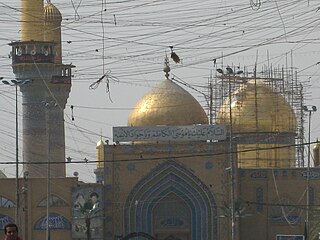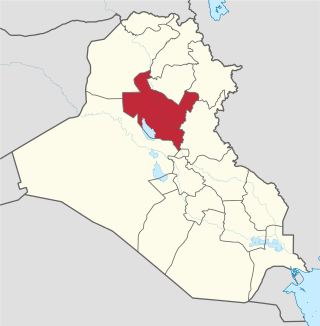
Balad, also transliterated Beled or Belad, is a city in Saladin Governorate, Iraq, 80 kilometres (50 mi) north of the national capital, Baghdad. It is the capital of Balad District. Located in Iraq's volatile Sunni Triangle, between the towns of Al Dhuluiya, Yathrib and Ishaqi, Balad's inhabitants are primarily farmers who work mainly on grape and date farms and as citrus growers.

Al-Kadhimiyya Mosque is a Shi'a Islamic mosque and shrine located in the Kādhimiya suburb of Baghdad, Iraq. It contains the tombs of the seventh and ninth Twelver Shī'ī Imāms, respectively Mūsā al-Kādhim and his grandson Muhammad al-Jawad. Also buried within the premises of this mosque are the historical scholars Shaykh Mufīd and Shaykh Naṣīr ad-Dīn aṭ-Ṭūsi. Directly adjacent to the mosque are two smaller shrines, belonging to the brothers Sayyid Raḍī and Sayyid Murtadā and Qadi Abu Yusuf al-Ansari.
Abū Jaʿfar Muḥammad ibn ʿAlī al-Hādī was a descendant of the Islamic prophet Muhammad and the son of Ali al-Hadi and the brother of Hasan al-Askari, the tenth and eleventh Imams in Twelver Shia, respectively. Some may have expected him to succeed his father al-Hadi to the imamate but he predeceased him in the garrison town of Samarra in Iraq, where al-Hadi was kept under surveillance by the Abbasids. His shrine is located near Baghdad, between Samarra and Kadhimiya. Considered a sacred site in Twelver Shia, his shrine was targeted by Sunni militants in 2016 in a deadly attack on its pilgrims.

In early July 2010, a series of bombing attacks in Baghdad, Iraq killed at least 70 people while injuring 400 during a Shia pilgrimage to Al-Kazimiyya Mosque, the mausoleum of Musa al-Kadhim. The bombings targeted those on the annual pilgrimage and took place from 6 to 8 July. The pilgrimage has been attacked in previous years by Sunni extremists and in 2005 was the site of a stampede that killed up to 1,000 people.
The following lists events that happened during 2014 in Iraq.
This is a timeline of events during the War in Iraq in 2015.
The following lists events that happened in 2015 in Iraq.

The Timeline of the War in Iraq covers the War in Iraq, a war which erupted that lasted in Iraq from 2013 to 2017, during the first year of armed conflict.
A suicide car bombing occurred on 17 July 2015 in the Iraqi city of Khan Bani Saad, targeting a local marketplace. As of 19 July 2015 approximately 130 people were killed in the bombing, with a similar number of injured. Several people were killed by collapsed buildings. The bomb was hidden under an ice truck in an attempt to attract more people amid the heat. Responsibility for the attack was claimed by the Islamic State of Iraq and the Levant (ISIL).
Shia Muslims have been persecuted by the Islamic State, an Islamic extremist group, since 2014. Persecutions have taken place in Iraq, Syria, and other parts of the world.
This article lists terrorist incidents in Iraq during 2016:
On 28 February 2016, at least 70 people were killed and 60 wounded in Sadr City, a southern suburb of Baghdad, as two bombs went off at a crowded market. The explosions ripped through a market selling mobile phones in the mainly Shiite Muslim district. The assailants were suicide bombers riding motorcycles through the crowd.
This is a timeline of events during the War in Iraq in 2016.
In May 2016, the Islamic State conducted a series of bombing attacks in and around Shia neighbourhoods in Baghdad, the capital of Iraq, killing and wounding hundreds. According to ISIL, attacks were aimed at Shia fighters.
On 13 May 2016, a group of militants armed with AK-47s attacked a cafe in Balad, Iraq, frequented by supporters of the Spanish football club Real Madrid. The Islamic State of Iraq and the Levant (ISIL) claimed responsibility for the attack. At least 16 people were killed and at least 30 were wounded.

On 3 July 2016, ISIL militants carried out coordinated bomb attacks in Baghdad that killed 340 civilians and injured hundreds more. A few minutes after midnight local time, a suicide truck-bomb targeted the mainly Shia district of Karrada, busy with late night shoppers for Ramadan. A second roadside bomb was detonated in the suburb of Sha'ab, killing at least five.

The attack on the shrine of seven Dujai was an attack on Friday, July 8, 2016, and claimed the lives of 36 people, following two bombings at least in the vicinity of the shrine of Sayed Mohammad in the southern Saladin Governorate, north of Baghdad. It is suspected that the ISIS terrorist organisation targeted the shrine with rocket-propelled mortars, followed by three suicide bombers, two of which detonated in a market near the shrine.
On 15 October 2016, four attacks in and around Baghdad, Iraq, resulted in the deaths of at least 60 victims and at least seven attackers, while injuring at least 80 more people. The Islamic State of Iraq and the Levant (ISIL) are believed to be behind the suicide bombing and two mass shootings.

A suicide bombing occurred in Iraq on 24 November 2016 when a truck bomb exploded at a petrol station in Hillah, some 100 kilometers from southern Baghdad, killing at least 125 people and injuring many others.







